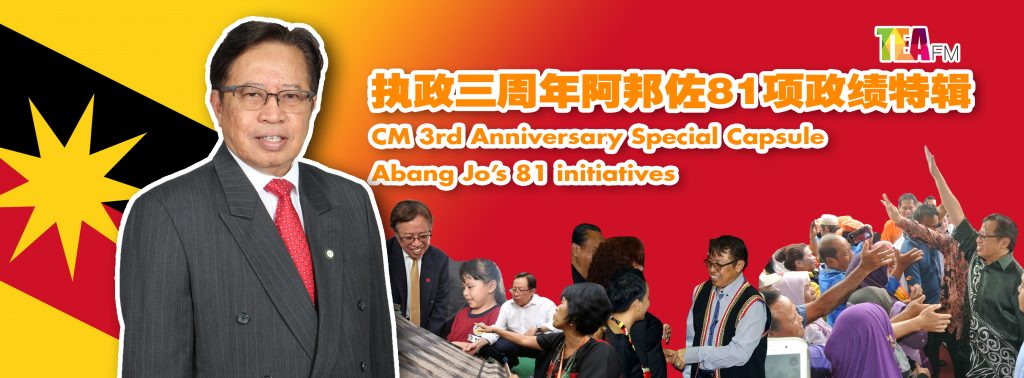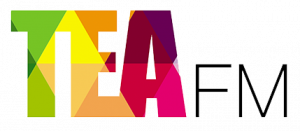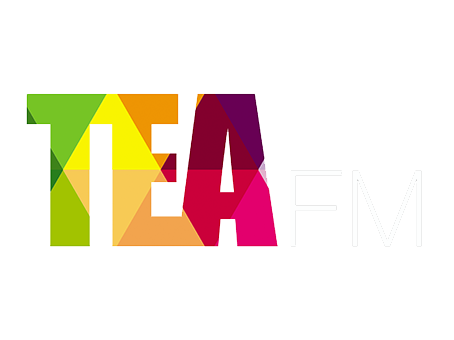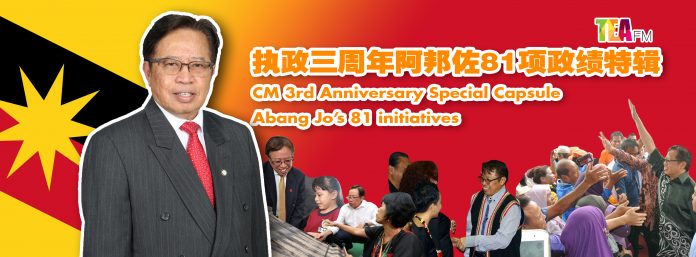
Ever since Datuk Patinggi Dr Abang Johari Tun Openg took office in 2017, he has helped the people of Sarawak in thriving for our rights and a better future. Yang Amat Berhormat has aided in the growth and development of urban areas; promote and propelled the digital economy in Sarawak and more. Therefore, in conjunction with Yang Amat Berhormat’s 2nd year anniversary as the Chief Minister of Sarawak, Tea FM is reporting the initiatives and effort introduced by Yang Amat Berhormat. Tune in this January 13th until January 14th for our Chief Minister of Sarawak, Datuk Patinggi Dr Abang Johari Tun Openg’s initiatives to accelerate economic growth in our beloved land of hornbill.
- Maintaining the interests, rights and status of Sarawak – To safeguard the special interests, rights and position of Sarawak as enshrined in the Malaysia Agreement 1963 (MA63) and Federal Constitution, the Sarawak government under the leadership of Abang Johari has established a Consultative Committee to determine and agree upon the representations for submission to the Sarawak representatives of the Malaysia Agreement 1963 (MA63) Steering Committee.
- Highest allocation for development under Sarawak’s Budget 2019 – This is to accelerate socioeconomic development for the benefit of the people.
- Strengthening integrity in the management of government projects – Establishing the Integrity and Ombudsman Unit, training integrity officers and increasing transparency in open tenders.
- Reduction of land premium – Land premium for all resettlement and village extension schemes have been reduced by 50 per cent. The premium has been fixed at RM2,500 per lot compared to the original rate of RM5,000 per lot.
- Defending the people’s right to land by recognising native territorial domain through the amendment of the Sarawak Land Code (Amendment) Bill, 2018.
- Establishment of the Sarawak Research and Development Council (SRDC), which was approved on Nov 9th, 2017 will oversee the promotion, coordination and advancement of research and development (R&D).
- Monitoring commission for high impact people’s projects – The Development Coordination Commission was established to monitor the implementation of the high impact projects to ensure that they are implemented and completed according to schedule for the people’s benefit.
- The International Digital Economy Conference Sarawak (IDECS) was held on April 3rd to 4th, 2017 and May 14th to 15th, 2018. IDECS has led to eight main initiatives towards a digital economy for Sarawak with the establishment of the Development Bank of Sarawak (DBOS), Sarawak Multimedia Authority (SMA), and Sarawak Digital Economy Corporation (SDEC). Other initiatives include increasing the speed of ICT infrastructure, building a digital village, promoting e-learning among the younger generation, promoting Sarawak as a data centre, and a digital plan for Sarawak.
- The Sarawak Digital Economy Strategy (2018-2022) was launched on December 13th, 2017. It involves 47 strategic actions to develop a digital economy with the anchor sectors being Agriculture, Manufacturing – Industry 4.0, Tourism, Smart City, Digital Health, e-Commerce, and Digital Government, which will be supported by infrastructure, digital skills and talent development, research and development, digital innovation and entrepreneurship, big data, and cyber security.
- Establishment of the Sarawak Multimedia Authority (SMA) – The SMA Ordinance was passed by the DUN in November 2017 and SMA was launched on December 13, 2017. The Sarawak Digital Economy Corporation (SDEC) is the lead agency for implementing the digital economy initiative in Sarawak.
- Establishing innovation hubs to nurture talents, support entrepreneurs, and create innovators for Sarawak through TEGAS Digital Innovation Hub, Kuching, launched on August 28, 2017, and Sarikei Innovation Centre, launched on September 17, 2017.
- Centre of Technical Excellence Sarawak (CENTEX) signed a memorandum of understanding with HUAWEI on Nov 10, 2017. It provides youth with digital training and skills development.
- Introduction of Sarawak ID – This digital identification system simplifies the people’s transactions with the government towards a digital government.
- Digital Kenyalang was launched on November 14th, 2017. The platform assists micro-entrepreneurs, particularly from low-income households, to market their products and increase their income.
- Sarawak Pay was launched on November 15th, 2017. The app enables cashless payments of bills and at selected retailers to prepare Sarawak for a digital economy.
- Sarawak e-Commerce Forum was launched on November 7th, 2017. The forum acted as a platform to encourage entrepreneurs to take up e-commerce.
- SarawakGov was launched on March 13th, 2017. The official app of the Sarawak government delivers up-to-date information about Sarawak.
- E-Commerce Transformation Plan – E-Com Y30, launched on April 5th, 2017 seeks to empower young Sarawakians as significant drivers for Sarawak’s transformation into a developed high-income economy. It seeks to provide them with the skills to take part in e-commerce.
- LASIS Mobile App – Launched on July 24th, 2018, the mobile extension of the Land and Survey Information System (LASIS) is an initiative by the Sarawak Land and Survey Department to provide a one-stop mobile app service to the public.
- Strengthening Science, Technology, Engineering and Mathematics (STEM) and Technical and Vocational Education and Training (TVET) – This was done by establishing the Sarawak STEM Education Lab as well as competency courses and TVET short courses.
- Repair and rebuild dilapidated schools in Sarawak through a special allocation under the Sarawak Budget.
- Providing financial assistance for government aided schools to enable them to upgrade infrastructure, buildings, and facilities.
- Strengthening English language usage to enable Sarawakians to master the fields of science and technology, and be able to communicate with the international community.
- Continuing support for Chinese-medium schools by recognising the Unified Examination Certificate (UEC).
- Increasing funds for scholarships by increasing the premium for hill timber.
- Increasing the number of doctors in Sarawak by sponsoring students to study medicine at Universiti Malaysia Sarawak (UNIMAS).
- Improving the quality of early childhood education by awarding an annual grant to every registered government and private preschool and kindergarten starting from January 2019.
- Building the best fundamentals in early childhood education – The Sarawak government will take over the operations of all 82 SeDidik preschools and kindergartens from 2019 onwards.
- Supplying treated water and electricity to rural schools – 33 schools have been identified for connection to the main pipe for treated water supply, and 113 schools for connection to the power grid at an estimated cost of RM 59 million.
- Expanding treated water supply coverage by the implementation of various water supply projects starting from 2019.
- Implementing the Sarawak Water Supply Grid programme – A special allocation was made to solve water woes to supply sufficient treated water to the whole of Sarawak.
- Implementing the Sarawak Alternative Water Supply (SAWAS) Programme – to provide safe and reliable water to the remote and isolated communities of Sarawak which cannot be connected to existing water supply systems.
- Full ownership of Bakun Dam – On 15th August 2017, the Sarawak government acquired the 2,400-megawatt capacity Bakun Hydroelectric Power Dam at Ulu Belaga from the federal government.
- Expanding rural electrification – Namely through the Sarawak Rural Electrification Scheme (SARES), Rural Power Supply Scheme (RPSS) and Rural Electrification Scheme (RES). 9.
- Construction of new bridges – The new bridges are the Lassa Bridge in Mukah, Batang Rambungan Bridge in Lundu, Bintulu-Jepak Bridge crossing Kuala Kemena in Bintulu, Batang Lupar Bridge in Samarahan/Betong, Batang Igan Bridge in Mukah, Batang Rajang Bridge, Batang Paloh Bridge, Batang Saribas Bridge in Pusa, Batang Kuala Saribas Bridge, Batang Lupar 2 Bridge, Batang Krian Bridge and Sungai Limbang Bridge.
- Construction of second trunk road and completion of coastal road network – to improve connectivity for the people as well as transportation of goods, especially in coastal and rural areas.
- Construction of airfields at Bukit Sadok and Bukit Mabong – to help rural residents in marketing and exporting agricultural produce directly to the primary market.
- Modernising the public transport system in Kuching – The Sarawak government suggested the use of ART for public transportation system to be implemented in 10 years’ time.
- Strengthening Unit for Other Religions (UNIFOR) was established on May 27, 2017, to look after the religious affairs of non-Muslims while also promoting peace, understanding, and unity in Sarawak. UNIFOR is also empowered to recommend and formulate policies, laws, and regulations relating to the religious affairs of non-Muslims in Sarawak.
- Venture Capital for Youth Entrepreneurs – Announced on Nov 17, 2018, the RM5 million initiative seeks to help youth entrepreneurs with creative and innovative ventures.
- Raising the salaries of community leaders and allowance of village chiefs since 2018 in recognition of the importance and contributions of community leaders and village chiefs in the service delivery system, particularly in rural areas.
- RM1,000 incentive for every Sarawakian newborn starting from Jan 1st, 2019 and is meant for them to further their education or as capital to pursue their careers.
- Service Sarawak – Launched on Dec 2nd, 2018, it offers a One-Stop Service centre at the Urban Transformation Centres in Kuching, Sibu, and Miri.
- Ensuring clean and sustainable management of the environment by utilising hydrogen and electric buses, starting with Kuching City in 2019.
- Identifying new revenue source via carbon trading – The Sarawak government is collaborating with SHELL and Edge Global Norway to explore nature conservation and restoration towards clean energy.
- Strengthening enforcement of forestry laws – improving the cooperation of enforcement agencies through the carrying out of joint operations and the implementation of the Sarawak Timber Legality Verification System (STLVS).
- Enhancing biodiversity research – the state entered a collaboration with the Natural Resources Institute of Finland (LUKE) to carry out joint research and development on sustainable forestry in Sarawak.
- Establishing Development Bank of Sarawak (DBOS) – established on 3rd November 2017 to finance strategic projects in Sarawak.
- Establishment of Petroleum Sarawak Bhd (PETROS) – established on August 6th, 2017 to develop the oil and gas industry in Sarawak.
- New agencies under the Regional Corridor Development Authority (RECODA) – Three agencies were formed under Recoda to spearhead development in specific regions of the Sarawak Corridor of Renewable Energy (SCORE) – namely Upper Rajang Development Agency (URDA) to develop areas in Kapit and upper Rajang, Highland Development Agency (HDA) to develop highland areas, and the Northern Region Development Agency (NRDA) to develop the northern region of Sarawak.
- Establishment of Integrated Regional Samarahan Development Authority (IRSDA) – The Integrated Regional Samarahan Development Agency (IRSDA) will spearhead and speed up development in the division.
- Ownership of 10 pct of shares in Petronas LNG Train 9 and increased ownership of MLNG3 shares from 10 pct to 25 pct to increase interests of the state government in the oil and gas industry and to generate higher state revenue.
- Increase Sarawak’s revenue through sales tax – From 1st Jan 2019, Sarawak is imposing a 5 per cent sales tax on petroleum products as a new source of revenue to support Sarawak’s development agenda.
- Establishing the Sarawak Regional Trade Office – Sarawak is collaborating with Singapore to strengthen the agriculture and tourism sectors. The Sarawak Regional Trade Office has been established. This will be followed by another two trade offices in Brunei Darussalam and Pontianak, Indonesia.
- Rebuilding of the Satok Suspension Bridge – The Sarawak government will reconstruct the iconic and historic Satok Suspension Bridge to become part of Kuching’s tourism attraction.
- Developing ‘Old Kuching Heritage’ as an attractive tourism product – It comprises four components, namely Kampung Heritage; Heritage Trail; Riverfront Heritage; and Business Heritage.
- Empowering the agriculture sector to increase output and improve the people’s income – The government has adopted the ‘anchor company’ model where such companies implement programmes and provide marketing assistance to smallholders. In addition, the focus is also on creating a new breed of modern farmers who are able to utilise the Internet of Things (IoT) and special apps to manage the fertigation of crops.
- Financing the development of the agricultural sector – To strengthen the business model of the agriculture sector, the government announced a venture capital initiative to groom and empower farmers and other agriculture industry players and bring them to a new level of modern farming. Additionally, a memorandum of understanding signed between Regional Corridor Development Authority (Recoda) and Agrobank allows easier financing for investors and farmers through special programmes.
- Implementing integrated agricultural development programmes through the setting-up of an agropark, the setting up of collection, processing and packaging centres (CPPCs), as well as Permanent Food Production Parks (TKPMs).
- Developing the capacity of Sarawak Farmers’ Organisation by building the headquarters of Sarawak Farmers’ Organisation (SFO) and increasing the annual allocation to all Area Farmers’ Organisations (PPKs) in the state.
- Three-tonne cargo plane for agricultural exports – through Hornbill Skyways to enable Sarawak to directly export its agricultural produce.
- Building more affordable homes – The Sarawak Government is committed to provide affordable homes to members of the lower-income group (B40) and the middle-income group (M40) through the village expansion scheme (SPK) in Lundu, Sematan, Igan, and Tian in Matu; as well as Affordable Housing Scheme (RMM) that has also been implemented in Darul Hana, Kuching; Kampung Tabuan Melayu and Tabuan Foochow, Kuching; Kemuyang, Sibu; Kampung Kapit Baru, Kapit; and Kampung Datu Baru, Sibu.
- Upgrading of infrastructure facilities and amenities of traditional villages under the Urban Renewal Programme – Under the programme, traditional villages in Kuching such as Kampung Kudei, Kampung Sungai Maong and Kampung Segedup had been earmarked for redevelopment.
- Reduce the construction cost of houses – To ensure the prices of houses do not burden the people, especially the low-income group (B40) and the middle-income group (M40), the Sarawak government advised developers to utilise the Industrialised Building System (IBS) for construction. The Housing Development Corporation (HDC) has also taken a positive step to build an IBS manufacturing factory in Kuching and the ground-breaking ceremony for the factory has been held on 28th March 2018.
- Providing more comfortable homes through Program Penambahbaikan Rumah Miskin Sarawak (PPRMS).
- Free School Bus – Free transportation for school students. This aims to help ease the financial burden of parents and reduce traffic congestion.
- RM30 Million Financial Aid under the Sarawak Micro Credit Scheme. This is used to provide loans to entrepreneurs to help ease their burden.
- State Allocation for the Sarawak Youth Venture Capital. RM5 Million had been set aside to upskill youths in various fields.
- RM30 million allocation to assist Sarawakian graduates to repay their PTPTN loans.
- Housing loans – to help those in the B40 category to purchase a house built by HDC.
- Water Bill Subsidy – Households in Sarawak will enjoy free water for their first RM 5 of the water bill which is equivalent to about 11,300 liters of free water.
- Extension of the 24-hour electricity supply grid to 14 000 rural households and 8 360 households using the off-grid system.
- Special assistance for fishermen during the monsoon season at RM300 a month for 5 months as well as equipment assistance.
- Post-natal-care assistance for mothers of RM450 – This aims to ease the financial burden of mothers.
- Provision of free electricity supply for rural villages or longhouses using off-grid systems (SARES and Hybrid).
- Electricity connection subsidy – Those in the low-income category which are charged up to RM5,000 for connection to the electricity grid will receive a full subsidy. While charges ranging from RM5,000 to RM10,000 will be 70% subsidised.
- State Government Allocation for the Village Development and Security Committee (JKKK) – RM100 Million was set aside for the operation of the JKKK program and allowance disbursement.
- State Government allocation for Artificial Reef Project on Sarawak’s Shoreline – RM60 million has been allocated for the artificial reef project in Sarawak’s waters to enhance fish resources. At the same time, it will increase the yield and income of the fishermen in Sarawak.
- Maritime Enforcement in Sarawak Coastal Waters – State Government has set aside Special Funds to strengthen coastal control activities aimed at protecting the waters and safeguarding State fisheries resources and fishing activities.
- light Fare Subsidy for Sarawakian undergraduates – The initiative is to ease the burden on Sarawakian students buying flight tickets during the festive season.
- Advance payments on Federal Government Loans for the Rehabilitation of Dilapidated Schools in Sarawak – This is done to accelerate repair works on dilapidated schools in Sarawak.









